Christopher alexander - A pattern language
Здесь есть возможность читать онлайн «Christopher alexander - A pattern language» весь текст электронной книги совершенно бесплатно (целиком полную версию без сокращений). В некоторых случаях можно слушать аудио, скачать через торрент в формате fb2 и присутствует краткое содержание. Жанр: Прочая научная литература, на английском языке. Описание произведения, (предисловие) а так же отзывы посетителей доступны на портале библиотеки ЛибКат.
- Название:A pattern language
- Автор:
- Жанр:
- Год:неизвестен
- ISBN:нет данных
- Рейтинг книги:3 / 5. Голосов: 1
-
Избранное:Добавить в избранное
- Отзывы:
-
Ваша оценка:
- 60
- 1
- 2
- 3
- 4
- 5
A pattern language: краткое содержание, описание и аннотация
Предлагаем к чтению аннотацию, описание, краткое содержание или предисловие (зависит от того, что написал сам автор книги «A pattern language»). Если вы не нашли необходимую информацию о книге — напишите в комментариях, мы постараемся отыскать её.
A pattern language — читать онлайн бесплатно полную книгу (весь текст) целиком
Ниже представлен текст книги, разбитый по страницам. Система сохранения места последней прочитанной страницы, позволяет с удобством читать онлайн бесплатно книгу «A pattern language», без необходимости каждый раз заново искать на чём Вы остановились. Поставьте закладку, и сможете в любой момент перейти на страницу, на которой закончили чтение.
Интервал:
Закладка:
Even in medium and high density areas where buildings are very close to each other and where there are strong reasons to connect them in a single fabric, people still insist on building isolated structures, with little bits of useless space around them.
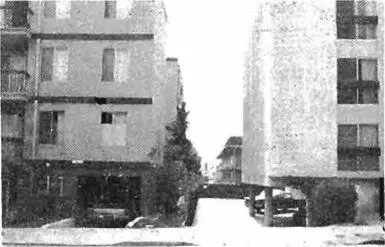
These buildings p re tend to be independent of one another — and this pretense leads to useless space around them.
Indeed, in our time, isolated, free-standing buildings are so common, that we have learned to take them for granted, without realizing that all the psycho-social disintegration of society is embodied in the fact of their existence.
It is easiest to understand this at the emotional level. The house, in dreams, most often means the self or person of the dreamer. A town of disconnected buildings, in a dream, would be a picture of society, made up of disconnected, isolated, selves. And the real towns which have this form, like dreams, embody just this meaning: they perpetuate the arrogant assumption that people stand alone and exist independently of one another.
532
| Io8 CONNECTED BUILDINGS* |
|---|
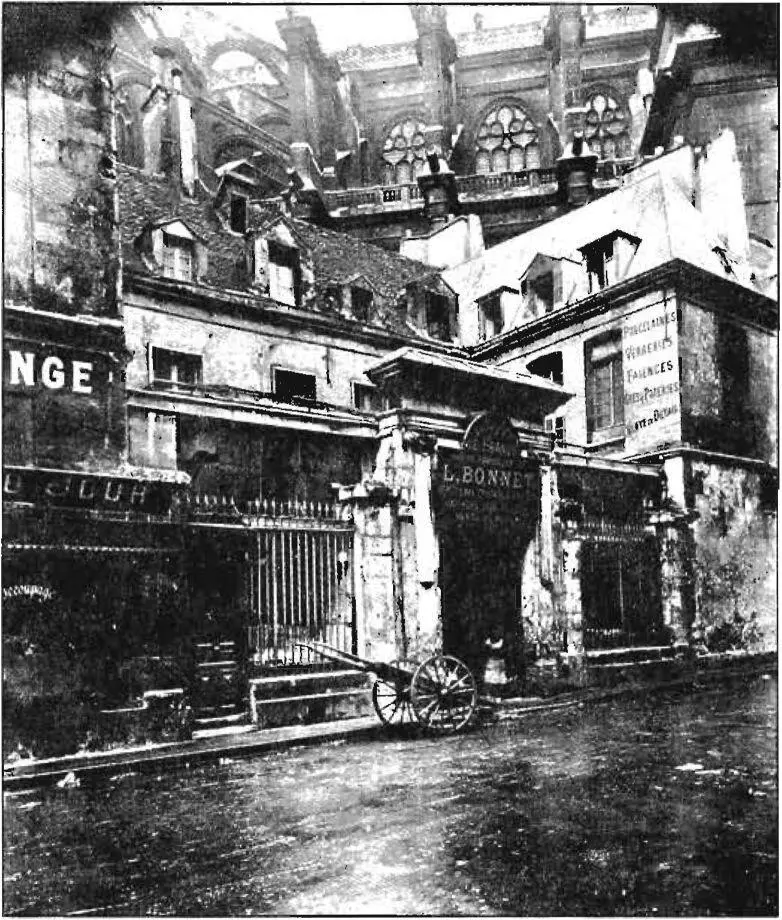 |
531
109 LONG THIN HOUSE*
. . . for a very small house or office the pattern of wings of light(106) is almost automatically solved—no one would imagine that the house should be more than 25 feet wide. But in such a house or office there are strong reasons to make the building even longer and thinner still. This pattern was originally formulated by Christie Coffin.
•£»
The shape of a building has a great effect on the relative degrees of privacy and overcrowding in it, and this in turn has a critical effect on people’s comfort and well being.
There is widespread evidence to show that overcrowding in small dwellings causes psychological and social damage. (For example, Wiliam C. Loring, “Housing Characteristics and Social Disorganization,” Social Problems, January 1956; Chombart de Lauwe, Famille et Habitation , Editions du Centre National de la Recherche Scientifique, Paris, 1959; Bernard Lander, Towards an Understanding of Juvenile Delinquency, New York: Columbia University Press, 1954.) Everyone seems to be on top of everyone else. Everything seems to be too near everything else. Privacy for individuals or couples is almost impossible.
It would be simple to solve these problems by providing more space—but space is expensive, and it is usually impossible to buy more than a certain very limited amount of it. So the question is: For a given fixed area, which shafe will create the greatest feeling of sfaciousness?
There is a mathematical answer to this question.
The feeling of overcrowding is largely created by the mean point-to-point distances inside a building. In a small house these distances are small—as a result it is not possible to walk far inside the house nor to get away from annoying disturbances; and it is hard to get away from noise sources, even when they are in other rooms.
535
TOWNS
Therefore:
| each region | |
|---|---|
| 1000 regions | 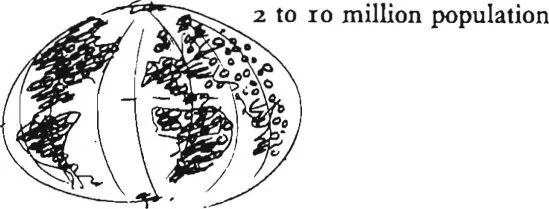 |
Wherever possible, work toward the evolution of independent regions in the world; each with a population between 2 and io million; each with its own natural and geographic boundaries; each with its own economy; each one autonomous and self-governing; each with a seat in a world government, without the intervening power of larger states or countries.
♦£* ♦£*
Within each region encourage the population to distribute itself as widely as possible across the region— the distribution of towns (2). . . .
BUILDINGS
To reduce this effect the building should have a shape for which the mean point-to-point distance is high. (For any given shape, we may compute the mean or average distance between two randomly chosen points within the shape). The mean point-to-point distance is low in compact shapes like circles and squares, and high in those distended shapes like long thin rectangles, and branched shapes, and tall narrow towers. These shapes increase the separation between places inside the building and therefore increase the relative privacy which people are able to get within a given area.
Buildings 'which increase the distance between -points . . .
Of course, in practice there are limits on the long-thinness of a building. If it is too long and thin, the cost of walls becomes prohibitive, the cost of heating is too high, and the plan is not useful. But this is still no reason to settle only for box-like forms.
A small building can actually be much narrower than people imagine. It can certainly be much narrower than the 25 foot width proposed in wings of light(107). We have seen successful buildings as narrow as 12 feet wide—indeed, Richard Neutra’s own house in Los Angeles is even less.
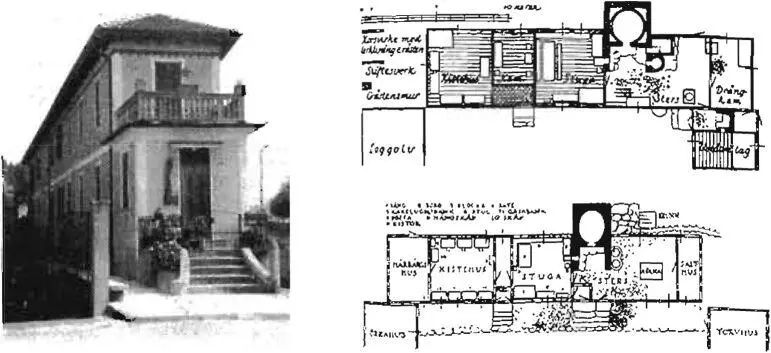 |
| Long thin houses. |
109 LONG thin house
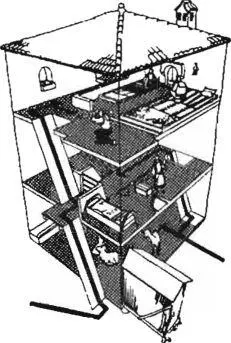
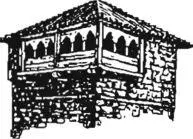
And a long thin house can also be a tower, or a pair of towers, connected at ground level. Towers, like floors can be much narrower than people realize. A building which is 12 feet square, and three stories high, with an exterior stair, makes a wonderful house. The rooms are so far apart, psychologically, that you feel as if you are in a mansion.
A Russian tower.
Therefore:
| string of rooms |
|---|
 |
| long thin rectangle |
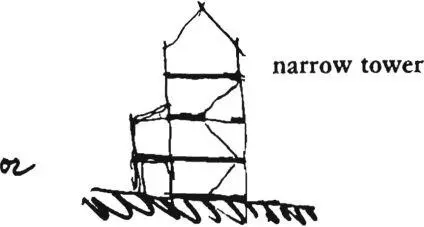
537
In small buildings, don’t cluster all the rooms together around each other; instead string out the rooms one after another, so that distance between each room is as great as it can be. You can do this horizontally—so that the plan becomes a thin, long rectangle; or you can do it vertically —so that the building becomes a tall narrow tower. In either case, the building can be surprisingly narrow and still work—8,10, and 12 feet are all quite possible.
BUILDINGS
^ ♦£«
Use the long thin plan to help shape outdoor space on the site— positive outdoor space(106); the long perimeter of the building sets the stage for intimacy gradient(127) and for the cascade of roofs(116). Make certain that the privacy which is achieved with the thinness of the building is balanced with the communality at the crossroads of the house— common AREAS AT THE HEART (I 29) . . . .
Читать дальшеИнтервал:
Закладка:
Похожие книги на «A pattern language»
Представляем Вашему вниманию похожие книги на «A pattern language» списком для выбора. Мы отобрали схожую по названию и смыслу литературу в надежде предоставить читателям больше вариантов отыскать новые, интересные, ещё непрочитанные произведения.
Обсуждение, отзывы о книге «A pattern language» и просто собственные мнения читателей. Оставьте ваши комментарии, напишите, что Вы думаете о произведении, его смысле или главных героях. Укажите что конкретно понравилось, а что нет, и почему Вы так считаете.












